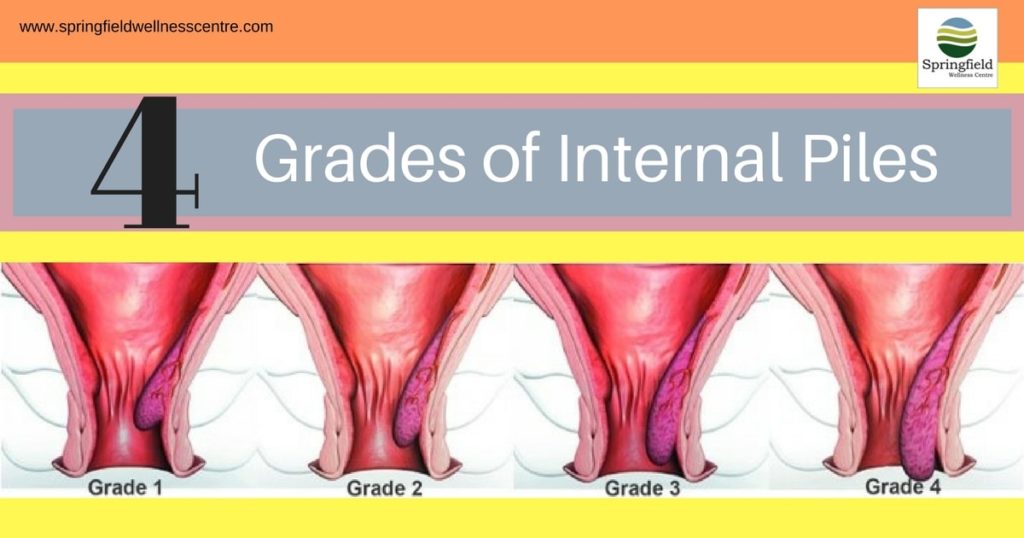Piles generally happen when the pressure in the veins in the rectal region increases and they swell like a bag of worms. This pressure is mainly due to constipation. Other reasons responsible are pregnancy, lifting heavy weights using improper lifting techniques, or chronic diarrhoea. We are aware that piles or haemorrhoids can be internal or external. We will delve deep into internal piles in this post.
Where does Internal Piles occur?
Internal piles occur above the dentate line also called as Pectinate line. It is a lining in the anal canal that divides the upper two third and the lower one third portion of the anal canal. The internal piles occur above this pectinate or dentate line.
The Four Grades of Internal Piles
Grade-1 Internal Piles
The piles condition is fresh and asymptomatic and is present internally above the pectinate line. Pain does not manifest at this budding grade of piles. Just that the veins that are facing the intense pressure are beginning to show symptoms of piles. The patient rarely feels discomfort at this stage. Some patients might experience itching and discomfort
Grade-2 Internal Piles
The piles condition begins to experience something called “prolapsed”. Prolapse is nothing but the veins becoming weak and beginning to be pushed out of the anal canal. The secondary grade piles condition is painful. The prolapsed veins get pushed up inside or reversed into the anal canal spontaneously. The patient feels discomfort and itching at this stage.
Grade-3 Internal Piles
This condition or grade is when the prolapsed veins becomes more painful and causes more discomfort because the spontaneous reversal or reduction of the prolapsed veins does not happen. However the patient can manually push the prolapsed veins inside.
Grade-4 Internal Piles
This final condition or grade is where the prolapsed piles cannot be pushed inside the anal canal manually also. The pileshangs outside and causes immense pain and discomfort.
Though internal piles is generically classified as per the above grades, the clinical classification based on what the gastro surgeon or piles specialist observes can be classified rather differently. These can be called stages and each stage is characterized by how piles manifests further.
Clinical Classification of Four Stages of Internal Piles
Stage-1 Internal Piles
When proctoscopy is done, less than 25% of the lumen is occupied by piles veins. Simply put, piles veins are beginning to appear to the piles surgeon upon observation.
Stage-2 Internal Piles
During proctoscopy session with the patient, if the piles specialist observes that the lumen of the proctoscope is occupied 25% by the veins of piles, then it can be categorized as Stage-2.
Stages-3 Internal Piles
Similarly if the lumen of the proctoscope is 50% occupied by the veins of piles during proctoscopy by piles specialist, then it is Stage-3. Additionally prolapse of the vein could be clearly observed by the piles surgeon and the surgeon could also confirm that the vein tuft automatically goes in.
Stages-4 Internal Piles
In this stage, the lumen of proctoscope is completely accumulated by veins of piles. The prolapes of the vein also takes place and it needs be pushed inside manually. In this stage, the veins cease to prolapse automatically inside.
Complicated Piles
The extreme end stage of the internal piles is termed as complicated piles. The veins are fully thrombosed and are completely prolapsed. Manually pushing the veins inside is absolutely not possible in this stage and it is extremely painful for the patients at this stage.
Conclusion of Dr Maran M on Internal Piles Classification
Dr. Maran, a gastro surgeon in Chennai treats piles and does Piles Surgery in Chennai regularly observes that if anyone has pain or any discomfort in the anal region, they have to immediately consult. If they see any droplet of blood in the stools it is best to consult a good gastro surgeon. The diagnosis of what has caused blood in the stool is absolutely required. Because sometimes it may not be piles or fissures, it can be something else also. So Dr. Maran always advices to take blood in stool with extra caution and suggests to visit a piles specialist sooner.
